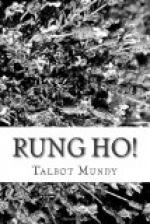The great palace of Howrah was ahum. Elephants with painted tusks, and loaded to the groaning-point under howdahs decked with jewels and gold-leaf, came and went through the carved entrance-gates. Occasionally camels, loaded too until their legs all but buckled underneath them, strutted with their weird, mixed air of foolishness and dignity, to be disburdened of great cases that eight men could scarcely lift; on the outside the cases were marked “Hardware,” but a horde of armed and waiting malcontents scattered about the countryside could have given a more detailed and accurate guess at what was in them.
Men came and went—men almost of all castes and many nationalities. Priests—not all of them fat, but every single one fat-smiling— sunned themselves, or waited in the shade until they could have audience; no priest of any Hindoo temple had to wait long to be admitted to that Rajah’s presence, and there was an everlasting chain of them, each with his axe to grind, coming and going by day and night.
Color rioted in the blazing sun and deep, dark shadows lurked in all the thousand places where the sun could never penetrate. It was India in essence—noise and blaze and flouted splendor, with a back-ground and underground of mystery. Any but the purblind British could have told at half a glance, merely by the attitude of Howrah’s armed sepoys, that a concerted movement of some kind was afoot—that there was a tight-held thread of plan running through the whole confusion; but no man—not even a native—could have guessed what secret plotting might be going on within the acres of the straggling palace.
From the courtyard there was no least hint obtainable even of the building’s size; its shape could only have been marked down from a bird’s-eye view aloft. Even the roof was so uneven, and so subdivided by traced and deep-carved walls and ramparts, that a sentry posted at one end could not have seen the next man to him, perhaps some twenty feet away. Building had been piled on building—other buildings had been added end to end and crisscrosswise—and each extension had been walled in as new centuries saw new additions, until the many acres were a maze of bricks and stone and fountain-decorated gardens that no lifelong palace denizen could have learned to know in their entirety.
Within—one story up above the courtyard din—in a spacious, richly decorated room that gave on to a gorgeous roof-garden, the Maharajah sat and let himself be fanned by women, who were purchasable for perhaps a tenth of what any of the fans had cost. Another woman, younger than the rest, played wild minor music to him on an instrument not much unlike a flute; they were melancholy notes—beautiful— but sad enough to sow pessimism’s seed in any one who listened.
His divan—carved, inlaid, and gilded—faced the wide, awning-hung opening to the garden. Round him on all three sides was a carved stone screen through whose interstices came rustlings and whisperings that told of the hidden life which sees and is not seen. The women with the fans and flute were mere court accessories; the real nerves of Asia— the veiled intriguers whom none may know but whose secret power any man may feel—could be heard like caged birds crowding on their perches.




